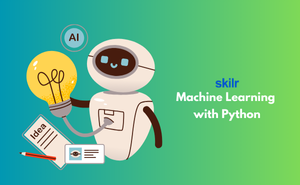👇 CELEBRATE CLOUD SECURITY DAY 👇
00
HOURS
00
MINUTES
00
SECONDS

Machine Learning with Python involves the use of Python programming language and its libraries to build and deploy machine learning models. Python's simplicity and readability make it an ideal choice for machine learning tasks, allowing developers to quickly prototype and experiment with different algorithms and techniques. Python's extensive libraries, such as NumPy, pandas, scikit-learn, and TensorFlow, provide powerful tools for data manipulation, preprocessing, model building, and evaluation. Machine learning with Python is used in various applications, including natural language processing, computer vision, and predictive analytics, making it a valuable skill for data scientists, machine learning engineers, and AI developers.
Why is Machine Learning with Python important?
Who should take the Machine Learning with Python Exam?
Machine Learning with Python Certification Course Outline
Python Basics
NumPy and pandas
Data Visualization
Data Preprocessing
Machine Learning Concepts
Model Selection and Evaluation
Supervised Learning Algorithms
Unsupervised Learning Algorithms
Model Tuning and Optimization
Model Deployment
Natural Language Processing (NLP)
Deep Learning
Feature Engineering
Ensemble Learning
Model Interpretability
Ethical Considerations in Machine Learning
Project Work
Case Studies
Best Practices in Machine Learning
Advanced Topics (Optional)
Industry-endorsed certificates to strengthen your career profile.
Start learning immediately with digital materials, no delays.
Practice until you’re fully confident, at no additional charge.
Study anytime, anywhere, on laptop, tablet, or smartphone.
Courses and practice exams developed by qualified professionals.
Support available round the clock whenever you need help.
Easy-to-follow content with practice exams and assessments.
Join a global community of professionals advancing their skills.
Python offers concise and meaningful code. While complex algorithms and versatile workflows stand behind machine learning and AI, Python's simplicity allows developers to compose solid systems. Python code is understandable by humans, which makes it easier to construct models for machine learning.
Machine learning is a subfield of man-made brainpower, which is extensively characterized as the ability of a machine to mirror keen human conduct. Man-made brain power systems are used to perform complex tasks in a manner that is similar to how humans solve problems.
Albeit a considerable lot of the high level machine learning tools are hard to use and require a lot of sophisticated information in cutting edge mathematics, statistics, and software designing, beginners can do a great deal with the basics, which are generally accessible. To master machine learning, some math is compulsory.